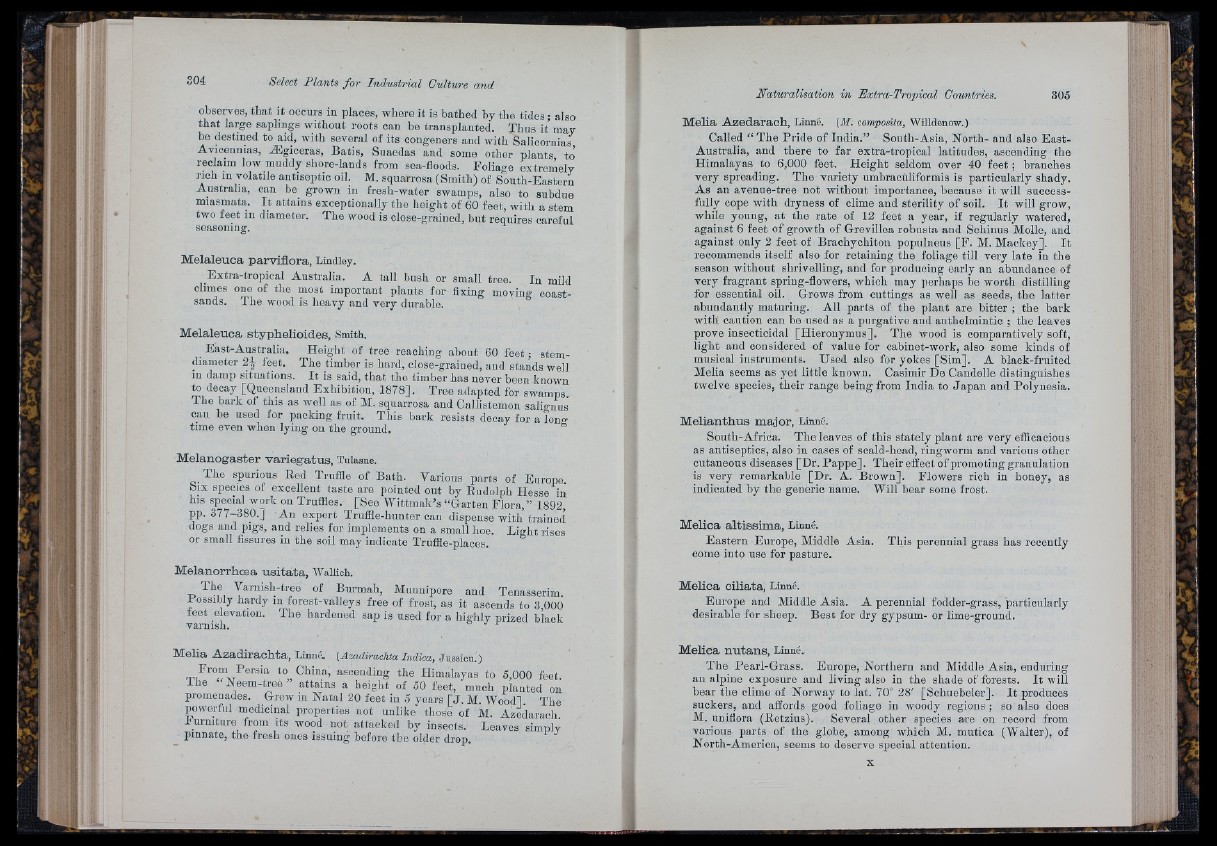
:
' Í-.'.
observes, that it occurs in places, where it is bathed by the tides ; also
th a t large saplings without roots can be transplanted. Thus it may
be destined to aid, with several of its congeners and with Salicornias
Avicennias, iEgiceras, Batis, Suaedas and some other plants to’
reclaim low muddy shore-lands from sea-floods. Foliage extreiéely
rich m volatile antiseptic oil. M. squarrosa (Smith) of South-Eastern
Australia, can be grown in fresh-water swamps, also to subdue
miasmata. I t attains exceptionally the height of 60 feet, with a stem
two teet in diameter. The wood is close-grained, but requires careful
seasoning.
Melaleuca parviflora, Lindley.
Extra-tropical Australia. A tall bush or small tree. In mild
climes one of the most important plants for fixing moving coast-
sands. The wood is heavy aud very durable.
Melaleuca styphelioides, Smith.
_ East-Australia. Height of tree reaching about 60 feet ; stem-
diameter 2 ^ feet. The timber is hard, close-grained, and stands well
in damp situations. I t is said, th a t the timber has never been known
to decay [Queensland Exhibition, 1878]. Tree adapted for swamps
The bark of this as well as of M. squarrosa and Callistemon salio-nus
can be used for packing fruit. This bark resists decay for a Tong
time even when lying on the ground.
Melanogaster variegatus, Tulasne.
The spurious Bed Truffle of Bath. Various parts of Europe.
Six species of excellent taste are pointed out by Rudolph Hesse in
his special work on Truffles. [See Wittmak’s “Garten F lo ra ,” 1892,
pp. 377-380.] An expert Triiffle-hunter can dispense with trained
dogs and pigs, and relies for implements on a small hoe. Light rises
or small fissures in the soil may indicate Truffle-places.
Melanorrhoea usitata, Waliich.
The Varnish-tree of Bnrmah, Munnipore and Tenasserim.
Possibly hardy m forest-valleys free of frost, as it ascends to 3,000
feet elevation. The hardened sap is used for a highly prized black
varnish. o ./ r
MeUa Azedarach, Linné. (M. composita, Willdenow.)
Called “ The Pride of India.” South-Asia, North- and also East-
Australia, and there to far extra-tropical latitudes, ascending the
Himalayas to 6,000 feet. Height seldom over 40 feet ; branches
very spreading. The variety umbraotiliformis is particularly shady.
As an avenue-tree not without importance, because it will suecess-
fully cope with dryness of clime and sterility of soil. I t will grow,
while young, a t the rate of 12 feet a year, if regularly watered,
against 6 feet of growth of Grevillea robusta and Scliinus Molle, and
against only 2 feet of Brachychiton populneus [P. M. Mackey]. It
recommends itself also for retaining the foliage till very late in the
season without shrivelling, and for producing early an abundance of
very fragrant spring-flowers, which may perhaps be worth distilling
for essential oil. Grows from cuttings as well as seeds, the latter
abundantly maturing. All parts of the plant are bitter ; the bark
with caution ean be used as a purgative and anthelmintic ; the leaves
prove insecticidal [Hieronymus]. The wood is comparatively soft,
light and considered of value for cabinet-work, also some kinds of
musical instruments. Used also for yokes [Sim]. A black-fruited
Melia seems as yet little known. Casimir De Candolle distinguishes
twelve species, their range being from India to Jap an and Polynesia.
MeUanthus major, Linné.
South-Africa. The leaves of this stately plant are very eflficacioiis
as antiseptics, also in cases of scald-head, ringworm and various other
cutaneous diseases [Dr. Pappe]. Their effect of promoting granulation
is very remarkable [Dr. A. Brown]. Flowers rich in honey, as
indicated by the generic name. Will bear some frost.
Melica altissima, Linné.
Eastern Europe, Middle Asia,
come into use for pasture.
This perennial grass has recently
MeRoa oiUata, Linné.
Europe and Middle Asia. A perennial fodder-grass, particularly
desirable for sheep. Best for dry gypsum- or lime-ground.
I ii
If
Melia Azadiraohta. Linné. (AzadiraoMa Indica, Jussieu.)
From Persia to China, ascending the Himalayas to 5,000 feet.
Ih e JNeem-tree’ attains a height of 50 feet, much planted on
promenades. Grew in Natal 20 feet in 5 years [ J . M. Wood] The
powerful medicinal properties not unlike those of M. Azedarach
lum itu re from its wood not attacked by insects. Leaves simply
pinnate, the fresh ones issuing before tbe older drop.
MeRca nutans, Linné.
The Pearl-Grass. Europe, Northern and Middle Asia, enduring
an alpine exposure and living also in the shade of forests. I t will
bear the clime of Norway to lat. 70° 28' [Schuebeler]. I t produces
suckers, and affords good foliage in woody regions ; so also does
M. uniilora (Retzius). Several other species are on record from
various parts of the globe, among which M. mutica (Walter), of
North-America, seems to deserve special attention.